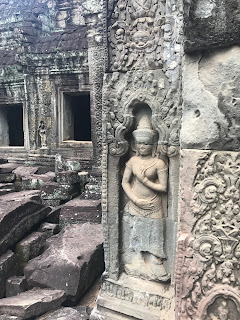Siem Reap ក្រុងសៀមរាប, home to the ancient World Heritage temples of Angkor Wat, was a bustling city and capital to the Khmer empire in the 12 - 13th century.
I'll be spending 4 days in Siem Reap, visiting the Tonle Sap lake floating villages, Angkor Wat, the local markets, join in on the crazy Khmer New Year water festival, and wrapping up at a visit to the National Museum to fill in any gaps on learnings. After Siem Reap I'll be heading over to Hanoi for a weekend in Halong Bay.
Siem Reap day 1 - Tonle Sap lake
Siem Reap day 2 - Angkor Wat sunrise (Angkor Wat, Angkor Thom, Ta Prohm)
Siem Reap day 3 - More of Angkor Wat (Preah Khan, Neak Pean, Ta Som, Bantaey Srei, Pre Rup)
Siem Reap day 4 - National Museum
----------------------------------------
Day 2 of Angkor Wat adventures! My driver, Mr. Sambo picked me up at 8:30am in the morning, much more humane than 4:45am yesterday. I'm visiting the other smaller temples around the complex, most of them built by Jayavarman VII in the 12th century. They are mostly similar in style, however unrestored. Compared to the other bigger temples like Angkor Wat and Angkor Thom, there are less people here and you see nature growing in harmony over these ruins.
Preah Khan – Quick Facts
- Built: 12th century
- King: Jayavarman VII to honor his father
- People: 100,000 officials and servants
- Name translation: Holy Sword (original name translates to holy city of victory)
Preah Khan is mostly unrestored so you see piles of stone on the sides, trees and plants growing out of the ruins. Near the middle of the temple is this small shrine looking object called "Stupa", and everyone is taking a photo of it with sunlight coming in from up top. A security guard offered to take loads of pictures for me which I’ll include at the end of this video, and of course he wanted a tip, so I gave him a small tip of $3 bucks.
Neak Pean – Quick Facts
- Built: second half of 12th century
- King: Jayavarman VII
- Purpose: medical, going into these pools would balance elements in the bather, thus curing disease
Ta Som – Quick Facts
- Built: late 12th century
- King: Jayavarman VII
- Purpose: dedicated to his father
- Religion: Buddhist
- Built: 10th Century (22 April 967 AD)
- Built not by a king, but by a brahman, who may have been a tutor of king Jayavarman V
- Religion: Hindu, god Shiva
- Temple name meaning: citadel of the women, or citadel of beauty.
Pre Rup
- Built: 10th century
- Built by Khmer King Rajendravarman II
- Purpose: state temple
Pre Rup is the very last temple I visited. Built in the 10th century by Khmer King Rajendravarman the 2nd, it’s the state temple at the time. The name translates to turning of the body, and it is common belief that funerals were conducted at the temple.
It’s been another long day, however tonight is the celebration of the Khmer new year. People rush on streets with their water guns and also baby powder for the street party. Some might say it is a cheesy party intended for foreign tourists who misunderstand the local culture and is just using it as an excuse to drink and party, however to my surprise, it was mostly locals enjoying this big celebration. I was drenched and covered in baby powder within minutes. Nonetheless I had a great time and I feel honored to have the chance to participate in the Khmer new year celebrations.
Tomorrow will be my last day in Siem Reap. I'll be wrapping it up with a visit to the Angkor National Museum to fill in the gaps of what I missed at the temples. After that I'll be flying off to Hanoi to see Halong Bay! Stay tuned.














































No comments:
Post a Comment